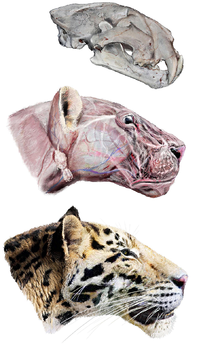Panthera tigris
The tiger (Panthera tigris) is one of the species of the subfamily of pantherines (family Felidae) belonging to the genus Panthera. It is found only on the Asian continent; It is a carnivorous predator and is the largest felid species in the world along with the lion, both of which can reach a size comparable to that of the largest felid fossils.
There are six subspecies of tiger, of which the Bengal tiger is the most numerous; its specimens constitute about 80% of the total population of the species; It is found in India, Bangladesh, Bhutan, Burma, and Nepal. It is an endangered species, and today most of the world's tigers live in captivity. The tiger is the national animal of Bangladesh and India.
It is a solitary and territorial animal that generally inhabits dense forests, but also open areas, such as savannahs. Normally, the tiger hunts animals of medium or large size, generally ungulates. In the six different extant subspecies of the tiger, there is a very significant variation in size. Male tigers are much larger than female tigers. Similarly, a male's territory generally covers a larger area than a female's.
Description
The size of tigers and other characteristics vary from one subspecies to another. In the wild, male tigers have a weight ranging from 47 to 258 kg and a length of 190-330 cm including the tail, which measures between 60 and 110 cm, and 61 to 122 cm in height. height at the withers Meanwhile, the much smaller females have a weight of 24-167 kg and a total length of 177-275 cm. Currently, the smallest subspecies is the Malaysian tiger, while the largest is the tiger. from Bengal. The total length of males is 270-310 cm while that of females is 240-265 cm; the tail is about 85-100 cm long and the height at the shoulders 58-110 cm.
Most tigers have orange or tawny fur, a whitish midsection and ventral area, and the stripes range in hue from dark brown to black. The shape and number of stripes vary according to their sex (if it is female, the number of stripes is less), although most tigers usually have fewer than 100 stripes. The stripe pattern is unique to each specimen and it is possible to use this to identify an individual, in the same way that fingerprints are used to identify a person. However, due to the difficulty of recording the stripe pattern in a wild tiger, this is not the most widely used method of tiger identification. Probably, the function of the stripes is camouflage, being useful to hide from possible prey. The stripe pattern is also found on the tiger's skin, so if it is shaved, its distinctive stripes can be seen.
Like most cats, tigers are believed to have some color vision. On the other hand, their night vision is very sharp thanks to the specular membrane located in the retina, which focuses the little light at night.
Like other members of its genus, the tiger has the ability to roar. Unlike other cats, although similar to the jaguar, the tiger is an excellent swimmer; can surprise and hunt prey in the water.
Territory
Adult tigers are often fiercely territorial and hunt extensively. Tigresses can have a range of 20 km², while the range of males is much larger, covering an average area of 80 km²; however, the size of the territory depends on the different populations of the tiger, with the territories belonging to the south-eastern Russian tigers being larger than those of any other tiger subspecies. Male tigers can allow several females to enter their territory, to the point of sharing prey and even feeding after the female (in the case of the lion, the exact opposite occurs, since the dominant male is the first to feed).); but they do not tolerate the entry of other male tigers into their territory. Due to their aggressive nature, territorial conflicts between tigers are violent and can end with the death of one of the males, although this type of death is less frequent than is believed, since in most of the fights for territory the males end up virtually unscathed. To mark his territory, the male sprays urine or other secretions on the trees.
There are several techniques to study the tiger in the wild; Some years ago tiger populations were estimated by plaster casts taken from their tracks. At present, the radio transmitter collar has become a very popular instrument for the study of the tiger in the wild.
Playback
A female is receptive for only a few days, and mating can occur several times during this time. Gestation lasts approximately 103 days, and after this period, the female gives birth to one to six pups weighing less than one kilogram.
Adult males may kill young to make females receptive.
At eight weeks old, the cubs are ready to leave their den and follow their mother. The young specimens become independent at approximately eighteen months of age, but until an approximate age of between two and two and a half years they do not separate definitively from their mother. Tigers reach sexual maturity at three to four years of age. Young tigresses generally establish their territory very close to their mother's, while males tend to roam in search of territory, which they usually acquire through fights with the male that owns a certain territory. Tigresses typically give birth to similar numbers of males and females throughout their lives.
Tigers are well bred in zoos or other conservancies, and in the United States alone, the captive tiger population is as large as the total number of tigers in the wild.[ citation required]
Diet
In the wild, tigers feed primarily on large ungulates, although, like many other predators, tigers are opportunistic and do not shy away from small prey such as monkeys, peacocks, hares, and even fish. In Siberia, the tiger's main prey items are elk, wild boar, shika deer, roe deer, and musk deer, while on the island of Sumatra, Timor deer, wild boar, and Malayan tapir are the most frequently hunted prey items. frequently by the Sumatran tiger. They are also capable of hunting large herbivores, such as gaurs, water buffalo, and elk.
Their usual prey also includes some other large predators such as striped hyenas, wolves, cuons, reticulated pythons, Indian pythons, Tibetan bears, sloth bears, sun bears, Siamese crocodiles, gharials, and false gharials; while on some occasions they attack cheetahs, leopards and crocodiles from the marshes, although they only devour those named felids in situations of scarcity of food, since they normally attack them because they are considered competitors for prey and because they represent a danger to their young. but they don't eat them. Cases of tigers having hunted saltwater crocodiles are known, although these are rare cases as both predators avoid meeting, but when the crocodile is on land or in shallow water, it becomes a potential prey for an adult tiger. On the other hand, Amur tigers and brown bears are a serious threat to each other and both tend to avoid each other. However, statistics indicate that the tiger is the most frequent winner in battles between the two animals, since the bears hunted by tigers are usually young or female bears, considerably smaller than male bears. In 2015 The Moscow Times published the news of a wild Siberian tiger killing a brown bear near the Amur National Park. Cases of fights between these animals are not very frequent, since the Siberian tiger and the Amur brown bear, in addition to being avoided, their population has also been reduced by man.
As for lions, there is currently nowhere where they naturally co-exist with tigers, but historically the two species co-existed in much of Asia. As lions live in herds (although smaller than African ones), tigers are the ones that should avoid them, while being sporadically alone, it is the tiger who ran ahead of the lion, even when both were adult males, although They do not prey (as can happen with tigers against leopards or cheetahs) but are seen as competitors for prey and a danger to their young.
A full-grown tigress is capable of killing a full-grown gaur single-handedly, despite weighing less than a sixth of the full-grown full-grown gaur.
Sambar and wild boar are the most frequent prey of the tiger in India; Asian elephants and young Indian, Javanese and Sumatran rhinos are occasionally hunted by tigers, most often when unprotected by their herds. There is a known case in which a tiger hunted an adult female Indian rhinoceros and her calf.Adult elephants are too large, strong and dangerous animals to be a tiger's prey.
Tigers prefer to hunt prey the size of sambar, gaur, or water buffalo, as they provide meat for several days, avoiding the need for another hunt. In all its populations, the tiger is the top predator and does not compete on an equal footing with other carnivores, with the exception of brown bears that exceed it in size and weight, the Asian wild dog, which compensates for its lack of strength with numbers, and in the past with the lion, which is similar in size and also lives in packs. Saltwater crocodiles and marsh crocodiles, being aquatic, do not compete with tigers for prey, since, apart from the fact that they often feed on the same species, they do so in different areas of an ecosystem. A hungry and desperate tiger may attack anything it considers potential food, even small vertebrates such as some species of amphibians, birds, mammals, fish, and reptiles.
Hunting Methods
Tigers normally hunt large herbivores; some examples are sambar deer, wild pigs, gaurs, water buffalo, and domestic cattle. Old or injured tigers are known to be the most likely to attack domestic livestock or humans; these tigers are commonly called "man-attacking tigers", which often leads to these pantherines being terribly eliminated by man. It is known that in the swamps of the Sundarbans located in Bangladesh and the Indian state of Bengal, which is where most incidents such as those mentioned occur, many healthy and in perfect condition tigers have sought to attack humans; this is largely due to the enormous human population density in such regions, which causes an overlap of the hunting territories of tigers and the territories inhabited by humans.
The tiger uses its size and strength to strike its would-be prey and bring it down. Despite their large size, tigers can reach speeds of up to 90 km/h (Amur tigers are capable of reaching this speed in a short run over Siberian snow). It also uses its muscles to hold up and knock down its prey, especially if it is large, such as a gaur. Once the animal is on the ground, the tiger bites the back of the neck, usually breaking the spinal cord, or puncturing the trachea, giving its prey an almost immediate death.
Adult tigers are capable of jumping up to five meters in height, or nine or ten meters in length, making it one of the highest jumping mammals (second only to puma in jumping ability[citation needed]).
The tiger's claws (typically around 7.5 cm long), combined with the force it can use to strike, make it capable of killing an adult ruminant with a single blow.
Anthropophagy
Instances of tigers having included humans in their diet are not uncommon, although these may have been greatly exaggerated.
The reasons that lead a tiger to adopt this behavior are the same as those of lions in Africa, and may be the senescence of the predator, the overlapping of the anthropic territory with the hunting territory of the pantherine, the defense of cubs during the breeding season or simply comfort for "easy" and abundant, as are the children and young people of the villages. There are registered cases in India (Sundarbans), Sumatra and Borneo. The Bengal tiger has the worst reputation, with some notorious specimens such as the Champawat tiger, which killed 430 people and was eventually shot by hunter and naturalist Jim Corbett. Observing its deteriorating teeth, Corbett was able to infer that the tiger had lost its ability to hunt its natural prey, turning to easier ones. Other cases involving the Amur tiger in Siberia are also documented although they are rarer. During the first half of 2014, four tiger attacks were reported in Sunderbans National Park.
Risk of extinction
Currently, the greatest enemy for the tiger is man.
The bones, and virtually all parts of the tiger's body, have been used in traditional Chinese medicine, although this practice has now been banned.
Illegal hunting for fur and habitat destruction have greatly reduced the wild tiger population. It is estimated that in the year 1900 there were around one hundred thousand tigers in the wild, distributed from the Anatolian peninsula to the island of Bali; in 1993 there were 7,000 left, two-thirds of them in India; in 2013 the wild tiger population was estimated to be about 3,000, while in captivity there are approximately 20,000.
In 2016, a WWF report estimated that the total number of tigers in the wild had increased for the first time in the previous 100 years, from an estimated 3,200 in 2010 to 3,890 in the year 2016. The objective announced then by the conservation movements would be to double the global population of tigers by the year 2022.
Evolution
Because the evolution of the tiger remains unclear, not much is known about its fossil record. The oldest confirmed fossils of the genus Panthera were discovered in 2010 in Tibet and classified in 2013 as Panthera blytheae, they are 4.1 to 5.9 million years old. years. The importance of these fossils lies in the fact that they reinforce the theory that felids belonging to the Subfamily Pantherinae originated in central Asia and not in Africa. The oldest remains of the tiger so far known were found and described in 2011 in China, specifically in the province of Gansu, dating back approximately two million years, to the early Pleistocene, with Panthera zdanskyi, a primitive cat smaller than a tiger, also known as "Longdan tiger". The oldest remains of true tigers come from Java, and are between 1.6 and 1.8 million years old. A subspecies, known as the Trinil tiger (Panthera tigris trinilensis), appeared approximately 1.2 million years ago, and was found in Trinil (Java). The tiger arrived in India and North Asia at the end of the Pleistocene, about 10,000 years ago. Fossil tigers were also found on an island east of Beringia (though not on the American mainland) and the island of Sakhalin. Some fossils were also found in Japan, remains indicating that the Japanese tiger was no larger than the more recent tiger subspecies.
Subspecies
Nine tiger subspecies inhabited Asia in recent times, of which three are extinct and another is in serious danger of becoming extinct in the not too distant future. Its historical distribution (today very reduced) passed mainly through Russia, Iran, Afghanistan, India, China and Southeast Asia, including the Indonesian islands. The following are the surviving subspecies of the tiger, in order of wild population:
- The Bengal tigeralso known as royal tiger or Indian tiger (P. t. tigris), is located in India, Bangladés, Nepal, Bhutan and Burma. It can be found in various places, from wet forests to savannah. The Indian government estimates that the total population of the Bengal tiger could be about 2000 wild specimens, of which about 1706 would be found in India. In 1972, India launched Tiger project, to protect the tiger population in India. The project resulted for a while, as the population of the Bengal tiger increased from 1200 copies in the 1970s to more than 3000 in the 1990s and is considered one of the most successful wildlife conservation projects. However, even though this tiger subspecies is the largest, it remains under a severe threat of being exterminated, as the destruction of its habitat and poaching (which have increased again due to the loss of effectiveness of the project) have caused the population of this tiger to have fallen significantly in recent years. The Indian tiger is one of the largest subspecies, with a weight of 175-260 kg for males and 100-160 kg for females. However, the tigers inhabiting Nepal and northern India tend to be larger than those inhabiting the centre of the Indian subcontinent and the Sundarbans.
- The Indochina tigerAlso called Corbett tiger (P. t. corbetti), is located in Cambodia, China, Laos, Burma, Thailand and Vietnam. Estimates of their total population in the wild state are variable, so it is not known for sure what their exact number is, although it is believed that at present it could be between 700 and 1300 individuals. The largest population of Indian tigers is in Malaysia, where illegal hunting has been controlled; however, all populations are threatened by habitat fragmentation and endogamy. The Indian tigers are smaller and darker than the Indian tigers; the males weigh 150-190 kilograms, while the females, smaller, weigh 100-130 kilograms.
- The bad tiger (P. t. jacksoni), found exclusively in the east of the Malacca peninsula, was not considered as an authentic subspecies until 2004. The most recent studies point out that its wild population could be just over 500 tigers, a figure that places it in the third largest tiger subspecies, behind the Bengal tiger and Indochina's. Malay tiger is a national animal in Malaysia. The average weight calculated for males is 120 kg, while that of females is 100 kg.
- The Sumatra tiger (P. t. sumatrae) is only on the Indonesian island of Sumatra. It is estimated that its wild population is between 400 and 500 copies, and is mainly found in the national parks of the island. The latest DNA analysis reveals the existence of certain unique genes, indicating that the Sumatra tiger is at the limit between the subspecies and its separation as a new species different from the rest of tigers if it is not extinguished before. For this reason, it has been suggested that further efforts should be made to preserve the Sumatra tiger than the remaining subspecies. The destruction of their habitat (which continues even in national parks supposedly protected) is their main threat; in addition, between 1998 and 2000, 66 tigers were shot dead, accounting for approximately 20% of their total population. Among the current subspecies of the tiger, Sumatra is the smallest, with a weight of 100-140 kg in the males and 75-110 kg in the females. Its small size is due to an adaptation to the dense forests of the island of Sumatra, where he lives. On 3 February 2007, a tiger of Sumatra pregnanted was captured by people in the village of Rokan Hilir, in the province of Riau. Some wildlife conservation officials are planning to move tigers to Bogor Zoo in Java.
- The Amur tiger (P. t. altaica), also called Siberian tiger, Manchuriaor Northern China is located in the region of Amur, in the Far East of Siberia, where it is currently a protected species. The latest census (in 2014) by the World Wildlife Fund (WWF) revealed that the wild population of the Amur tiger consists of about 400 specimens, a population that is now more or less stable. It is considered the world's largest felide (with the exception of the bleed, a hybrid between a lion and a tiger), the largest specimen hunted in the wild was a male with a weight of 384 kg and a specimen in captivity reached 465 kg; however, the average weight for males is 225 kg, and for females of 127 kg. A specimen of only six months old can be as large as an adult leopard. It is characterized by a thick layer of fat (especially in winter), in addition to a leoned coat, paleer than the other subspecies; as well as a smaller number of stripes.
- The South China Tiger (P. t. amoyensis), also known as tiger of Amoyor of Xiamen, is the most threatened tiger subspecies of all, and faces its almost imminent extinction. It's one of the smallest subspecies Panthera tigris; males weigh 130-175 kg and females, considerably smaller, usually weigh about 100-115 kg. The last savage southern tiger was hunted in 1994, and since then no more sightings of wild tigers have been confirmed. In 1977, the Chinese government passed the law prohibiting the hunting of tigers in freedom, but it seems to have been too late to save the subspecies. Currently there are only 59 specimens, which descend from 6 captured animals, all of them currently live in Chinese zoos. Efforts are currently being made to reintroduce these tigers by 2008.
Extinct subspecies
During the XX century, three other subspecies became extinct due to hunting and habitat degradation:
- The Bali tiger (P. t. balica) existed only on the remote island of Bali. The Balinese tigers were sought and hunted until their extinction on 27 September 1937, with an adult female hunted in Sumbar Kima, in western Bali. The tiger of Bali was the smallest subspecies of the tiger; with a maximum weight of 100 kg. in the males and 80 in the females.
- The Java tiger (P. t. sondaica) lived only on the island of Java. The subspecies is probably extinct since the late 1970s, as a result of hunting and destroying their habitat; however, their disappearance was already likely in the early 1950s (when less than 25 specimens were thought to exist in the wild). The last java tiger was spotted in 1979.
- The Caspian tiger (P. t. virgata) was the only tiger that lived in western Asia, covering countries such as Afghanistan, Iran, Iraq, Pakistan, Russia and Turkey. He suffered a harsh extermination campaign in the tsarist Russia. The last Russian specimen was shot down in the current Azerbaijan in 1923, and the subspecies disappeared definitively when the last Iranian tiger fell in 1959. It was a voluminous tiger, almost as big as Bengal's tiger, the males could reach 240 kg. It was one of the two tiger subspecies (together with the Indian) that, in addition to the Atlas lion and other animals were used by the Romans to fight with gladiators.
Prehistoric subspecies
- Panthera tigris acutidens: This tiger subspecies lived in Asia during the early Pleistocene period of the Cenozoic era. Its remains were discovered mainly in China in locations such as Yen Ching Kao, Wanhsien and Zhoukoudian (located about 42 km southwest of Beijing). Panthera tigris acutidens it had a size similar to that of the largest modern tiger subspecies, but it was characterized because its metapodials had a much more massive constitution than those of any current tiger.
- Panthera tigris soloensis: this tiger subspecies lived in what is now known as the Sonda region (Indonesia) about 195 000 years ago. Only about seven incomplete specimens are known, although in good condition, which were discovered on the island of Java, including a full skull, two humeros and a large femur. Its size was very similar to the Bengal tiger, but some specimens indicate the existence of larger individuals.
- Panthera tigris trinilensis: this variety of tiger is known for the fossil remains found in the region of Trinil, Java (then its name). This tiger lived between 1.2 million and 700 000 years ago.
Other non-taxonomic varieties
There are varieties of tiger that acquire their own physical characteristics without constituting the group into a subspecies. Among these varieties are:
- White tigers are specimens of tiger (Panthera tigris) with a genetic condition that almost eliminates the pigment from its coloration normally orange, although black stripes are not affected. This occurs when a tiger inherits two copies of the recessive gene for pale coloring: pink nose, blue eyes Ice, and white skin cream with black, grey or chocolate-colored stripes. White tigers do not constitute a separate subspecies and are fertile with orange tigers, although all the resulting calves will be heterozygotes by the recessive gene, and their coloring will be orange. The only exception would be if the orange parent was also a heterozygous tiger with recessive gene for pale coloring, which would give him 50% chances of being double recessive for white or heterozygous for orange.
- A golden tiger, or golden tabby, as it is known in English), is a tiger with an extremely rare color variation, caused by the action of a recessive gene. These golden tigers can currently only be found in captivity. Like the white tiger, the golden tiger is a color variation and not a different species. The gene that causes this unusual color is related to skin bands, while in white tigers, it is a color inhibitor gene (chinchilla). There is currently little less than 30 of these rare tigers around the world, although many more are carriers of this recessive gene.
- The term blue tiger or tiger maltés, refers to a suspected mutation of the color of the fur that might have some tigers, mainly “seen” in the China province of Fujian. It has been said that they possessed a bluish skin with rays of a dark grey tone. The term “maltes” comes from the terminology used to refer to some individuals of domestic cats that have a blue grey skin. Particularly on the island of Malta there is a considerably high number of domestic cats with this characteristic, which has led to the use of this term in reference to tigers with such coloration, however, the latter have no relation to that island.
Hybrids
Most of these hybrids occur with animals in captivity, however, some of these peculiarities have also occurred in the wild.
- Liger: It is the cross between a male lion and a tiger. They possess physical characteristics and behavior of both parents. However, they tend to grow much more than either parent. Male ligres are sterile, but female ligres are usually fertile.[chuckles]required]
- Tigon: The chariot is less known, and it is the result of the cross between a male tiger and a lioness. The tigons are usually relatively small, as the males weigh about 150 kg, approximately 20% smaller than a medium-sized male lion. Like the ligres, the tigons have physical and behavioral characteristics of both species, and the males are also sterile.
Tiger as national animal
Currently the tiger is a national animal in several Asian countries:[citation needed]
- Bangladés (Bengal Tiger)
- China, along with the dragon and the panda; the tiger is an unofficial symbol
- India (Bengal Tiger)
- Malaysia
- Nepal (Bengal Tiger)
- North Korea (Amur Tiger)
- South Korea (Amur Tiger)
Contenido relacionado
Pinidae
Kidney
Biotechnology































